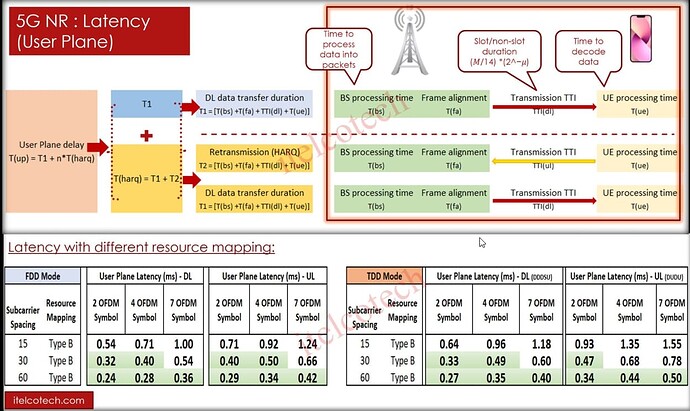5G NR Latency (User Plane) is the time duration a message/packet takes to reach the destination from source at radio level on protocol layer 2/3. Source/ destination here can be a user equipment (UE) or a base station (BS). Latency is measured either from BS to UE (Downlink) or from UE to BS (Uplink) for a given service. It is measured in milliseconds (ms).
As per ITU, User plane latency requirement for eMBB is 4ms and that for URLLC is 1ms in NR
As per 3GPP, User plane latency requirement for eMBB is 4ms and that for URLLC is 0.5ms in NR
URLLC latency requirement is very stringent and needs a robust/flexible network architecture/design to achieve it. URLLC is one of the enabling factors in the fourth industrial revolution but involves huge investment by telcos to deliver such low latency services
URLLC, eMBB and mMTC services can coexist within the same spectrum in both time and frequency domain in multiplexed manner. URLLC can pre-empt ongoing eMBB transmissions, if required. URLLC services can be mapped to small number of OFDM symbols (preferably 2 or 4) along with higher subcarrier spacing (30/60kHz) to achieve lower latency (as shown in the table below). eMBB services on the other side can be mapped in the opposite way.
Note:
· Resources are mapped in 2 ways, and it impact the start timing of a transmission:
Type A: Transmission starts at symbol 0 in UL and at symbol 0,1,2 in DL (3 for DMRS only)
Type B: Transmission starts at any symbol from 0 to 11 in a slot. Allows immediate transmission
· Processing time depends upon resource mapping type, subcarrier spacing and UE capability (depends upon symbols used for PDSCH processing/PUSCH preparation). UE capability 2 and Transmission type B is considered in calculation
· Scheduling can happen at 2/4/7/14 symbols in a slot
· n is the number of HARQ retransmissions. In this calculation, probability of HARQ retransmissions considered is zero (ideal scenario)
· TDD DL - frame structure considered is DDDSU considering best DL latency achieved
· TDD UL – frame structure considered is DUDU considering best UL latency achieved
· Latency may vary depending on network architecture. No delay related to fronthaul and midhaul is considered
· T(tti): Slot/non-slot duration = (𝑀/14) *(2^−𝜇), M means 2,4,7,14 OFDM symbols and μ is subcarriers spacing. Small number of symbols (M) and higher subcarrier spacing (μ) can reduce tti and hence the overall latency
· Evaluation process shown below is for DL. For UL, process is almost similar.
Reference - ITU
LinkedIn: ![]()
